| |
|
|
|
1955-1DO-001 struck counterfeit
It is always wise to be very wary of what you
purchase, especially when it comes to buying valuable coins. The
purpose of this page is to help you determine whether that "king
of kings" doubled die you have your eye on is genuine. The
specifics of this document and the photographs that follow are an
example of what to watch for in struck counterfeits of valuable
coins - this by no means is the only type of counterfeit nor is
it the only die with which struck counterfeits are made, so do not
pick any specific markers off of the photos of the counterfeit below
and read them as being exactly what to look for in determining a
1955 doubled die to be counterfeit or genuine. Since there are other
methods and other counterfeit dies used, certification or authentication
BEFORE purchase is the only sure way to tell whether you have the
"real deal" or a fake. Reading a bit between the lines,
you can derive from my statement that you should either VERY WELL
know what you are doing in buying an uncertified specimen, or stick
to certified (slabbed) specimens.
The
struck counterfeit documented here was sent in by K. Reichert, who
was genuinely gracious in allowing me to examine this piece after
having received it back from ANACS as a struck counterfeit. Very
luckily, he is going to be refunded for this coin, but his case
is an exception. MANY people are fooled by these coins because the
method used to create them is very close to that which made the
genuine specimens. Without detailed analysis it is very difficult
to tell the difference between them.
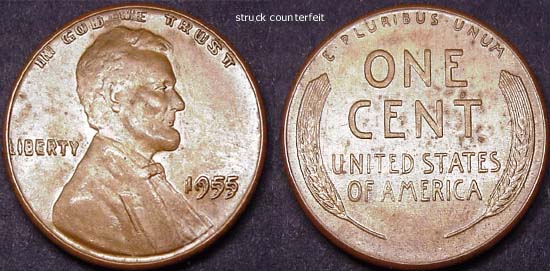
This
macro image of the struck counterfeit looks quite convincing. In
fact, without magnification it is very difficult even for a seasoned
specialist to detect. The only real sign of a counterfeit from this
viewpoint is the rim of the coin. If compared to just about any
other genuine cent from that era, it is a curiosity that the rim
is nearly razor sharp and the edges of the coin are more rounded-off
than a genuine cent. Other than that, this coin (without magnification)
could easily be passed off as genuine. Its weight is within tolerance
of a genuine cent (3.10 grams), its thickness is about right, and
it appears to be made of the correct alloy.
Since
more detail is required to assess the problems with the counterfeit, I
have taken the liberty of using photographs of a genuine 1955 doubled
die to compare with this struck counterfeit. The genuine doubled die,
at the time it was photographed, belonged to collector Jim Hiironen. I
use the genuine coin to compare to the counterfeit more so that you can
see the differences side by side, but viewing a genuine coin at the same
time as a counterfeit is not entirely necessary nor is it often possible.
In that, it is important that you be able to recognize the characteristics
of the counterfeit as it stands alone, not just in a side by side comparison
with a known genuine specimen.
|
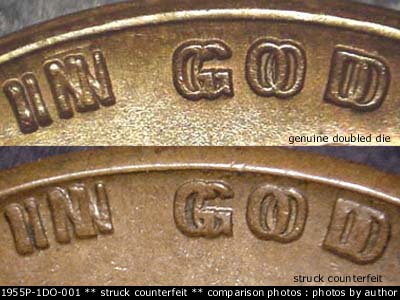
|
The
first photograph shows immediate problems that will carry forward
to other photographs below. Note the thickness difference in the
rim as described above. Also notice the acute flatness of the devices
on the counterfeit. They seem rather wide, yet flat. The overall
relief is lower, and the devices are the wrong distance from the
rim. Notice how close "IN GOD" is from the rim on the
counterfeit.
Another
problem that will be revisited throughout these photographs is that
some of the devices (such as the "D" in this photo) are
unusually thicker than other devices on the counterfeit. Notice
the equal thickness of different features on the genuine coin.
|
|
The
next image carries forth all of the previously mentioned problems,
but adds another problem to the list. Notice the weakness and flatness
to the left side of the "W" on the counterfeit. It is very likely
that the planchet used for this coin was not subjected to an upset mill to raise the rim.
Rather, the field of the die was curved to assimilate the relief of the rim. When the
"W" was hubbed into the die, it was hubbed too closely to the curved rim, thus came
out incomplete on top. A genuine 1955
doubled die will not show this sort of characteristic anywhere on
the coin.
I
feel it is very important to stress that this particular problem
is evident on the "W" in "WE" on this particular
counterfeit, but is by no means an absolute with all struck counterfeits.
Weakness may show in a different area of a different counterfeit.
|
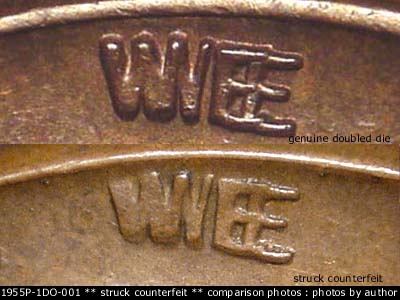
|
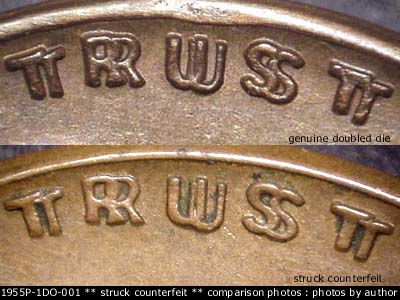
|
The
next image shows another curiosity usually found on counterfeits
that will never be found on the genuine doubled does. Notice the
cut "gap" in the center of the doubled "U" in
"TRUST." This was likely done because the separation between
the devices did not show well, so a gap was added to the hub in
order to make the resulting coins look more genuine.
Notice
also that in this particular area of the coin the devices are all
more or less properly spaced from the rim. As a side note, the dent
in the rim on the genuine specimen is a coin hit, not a feature
of the die.
|
|
The
face (actually the entire bust) shows notable weakness in detail,
quite visible in this particular example as a lack of lower nose
detail - namely the separation line that shows on the genuine specimen
is non-existant on the counterfeit. The doubling shows above the
eye on the counterfeit, but shows a distinct lack of shape to the
primary eyelid, another "sign".
Notice
also the general lack of sharpness to the bridge of the nose, nostril,
front of the eye, the crease in the lip, and the crease in front
of the cheek. The list goes on and is evident throughout the design,
this photo should be enough to give a general idea of the overall
weakness in the counterfeit. The detail in the hair, ear, coat,
and shoulder folds also carry this weakness.
|
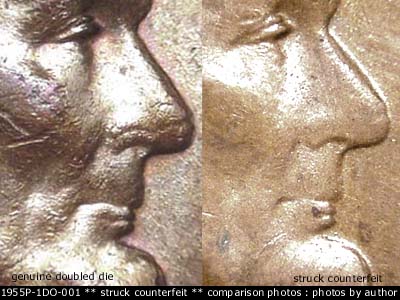
|
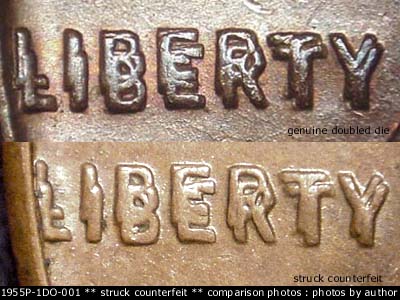
|
The
area around "LIBERTY" is where these particular counterfeiters
went really wrong. Notice how the "L" crowds the rim in
the counterfeit, and it is quite misshapen by this. Again, this
won't necessarily be the case with all struck counterfeits, but
something like this may be apparent with any number of them.
Notice
also the lack of detail, namely separation lines, in the letters.
Oddly enough, though, one of the signs of a genuine 1955 doubled
die does show here - the angled "cut" across the top of
the "E." This is a feature of nearly all 1955 cents. A
lesson - don't just look for one thing - observe all the details.
|
|
The
last feature to cover on the obverse is the date. Both coins show
the weak top of the 1, an apparent sign on all genuine 1955 cents...once
again, study the whole piece. Signs of genuine attributes will often
come through on counterfeits.
Notice,
however, that there is a distinct "cut" between the "1" digits
on the counterfeit. Again, a tooling effect probably done to separate
the devices from one another to make the finished product look more
genuine.
As
mentioned above, the date digits appear to be somewhat shallower
in the counterfeit, as well as more squared-off in relief.
Take
note also that one of the markers for a genuine 1955 doubled die,
the light NW-SE die scratches through the date are not present on
the counterfeit.
|
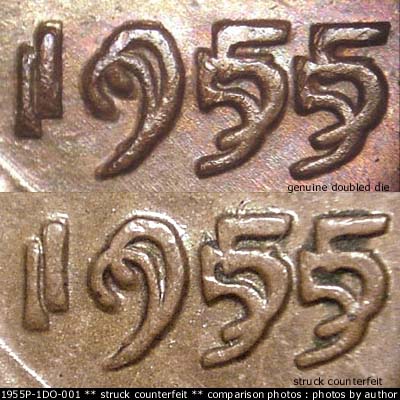
|
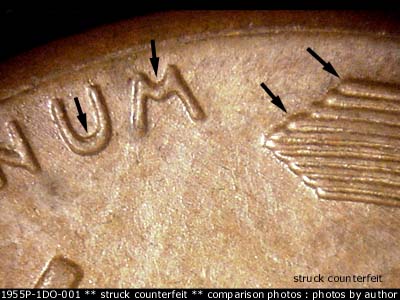
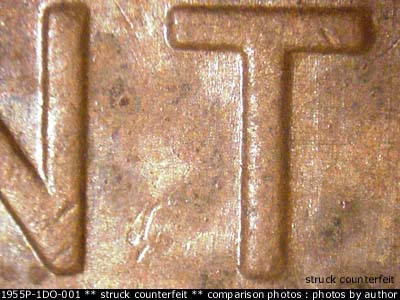
|
Finally,
the reverse. This particular reverse shows a light class 2 doubled
die with minor separation showing in the motto and right wheat lines.
Of course the genuine doubled dies do not show this doubling. The relief on the entire reverse
is also too shallow for a genuine coin. Interestingly enough, the top of the O in ONE
is complete, which is a common weak point in genuine wheat cents. This can be
attributed to the low relief being able to strike up more detail with less pressure.
The
other typically known marker (sorry, no photo) is the X shaped die
scratch to the left of the T in CENT. The counterfeit does not show
this marker, although it does have die scratches in that area which could
be mistaken for the die scratches on the genuine doubled die. One of the
problems with using these die scratches as the only key for determining a coin
to be real is that often the color or luster (or lack of) will effectively hide the
presence of these scratches. Weak strike or any number of other slight anomalies can
also make them weak and nearly invisible. Also important is the fact that the counterfeit shows
a criss-cross pattern of very light and very thin die scratches
throughout the reverse, also not present on genuine specimens.
I
apologize for the depth of this article, but I wanted it to be perfectly
clear from beginning to end that it is VERY important that you know
all of the different possible attributes of a counterfeit doubled
die, so you would be more aware when shopping for them. I also wanted
to stress the importance in knowing that this is only one example
die pair, NOT the only one used, so it is of equal importance to
remember that the particluar anomalies shown on this counterfeit
will not necessarily carry through to all struck counterfeits, and
certainly not to cast counterfeits or those made by other, usually
more crude methods.
|
|
|

